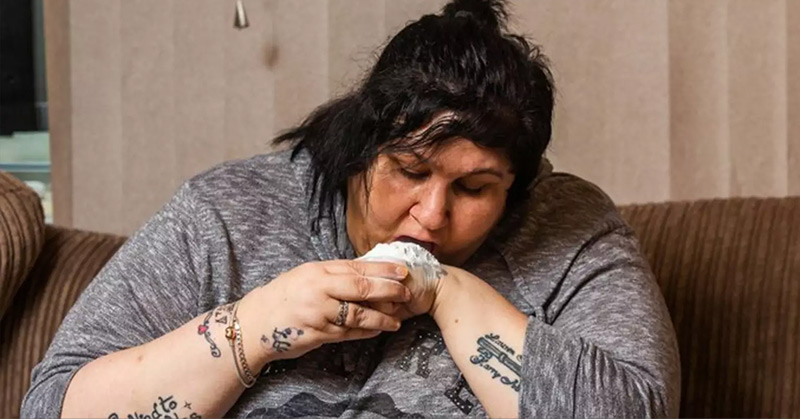When you were a child, did you ever eat (or try to eat) something that isn’t supposed to be food? Or maybe when you got a little older you were dared by your friends on the playground to eat a non-food item, like paper or dirt? These are usually one-off instances and are fairly harmless, but for some people, consuming non-food items can actually become a serious problem. For one UK woman, a baby powder addiction has been tough to kick.
A Baby Powder Addiction
Lisa Anderson, a 44-year-old mother of five living in the UK is addicted to eating talcum, aka baby powder. This habit, which has her consuming nearly one half-pound bottle of the white powder every day, has cost her more than ten thousand dollars [1].
The habit began in 2004 when she was drying her son off after a bath and she noticed a bit of baby powder had come off of the bottle.
“I had this sudden urge to eat it, and I just couldn’t fight it,”[1].
Since then, her craving has developed into an alarming addiction which has her licking the powder off of her hand every thirty minutes up to forty times per day. She now constantly eats mints whenever she is out of the house to keep her craving for the chalky texture at bay [1]. While this all may sound like fiction, Lisa’s type of addiction does have a name – Pica.
What is Pica?
Pica is a type of eating disorder that involves consuming nonfood items that contain little to no nutritional value, such as paper, dirt, chalk, or wool [2].
In order to be classified as Pica, the behavior has to be persistent for at least one month and cannot be a part of a religious ceremony. A patient who is less than two years old cannot be diagnosed with the condition, since eating non-food items is a common part of child development [2].
There is no laboratory test for Pica. Instead, diagnosis is based completely off of clinical history of the patient (ie- a patient tells you they’ve been engaging in this behavior) [3].
There is no singular cause for Pica, however, in some cases it could actually be your body’s way of attempting to correct a nutrient deficiency. Iron-deficiency anemia and malnutrition are the two most common causes of Pica. For this reason, pregnant women who have low iron levels may be more likely to develop the disorder [3].
Is Pica Dangerous?
Pica can be harmful depending on the person and on what they are eating. It often occurs with other mental health disorders like autism spectrum disorder or schizophrenia, which could be cause for concern [3].
Usually, Pica does not cause significant harm from a medical standpoint, but there are a few complications that could develop:
- Intestinal obstruction. The nonfood item being consumed could end up obstructing (aka blocking) your bowels, which could lead to cramping, vomiting, complete constipation, and lack of gas production [2,4].
- Lead poisoning. One common Pica addiction is paint chips, which could contain lead. Lead poisoning can cause complete encephalopathy (brain disease or damage), or irreversible organ damage [2,5].
- A parasitic infection. If the addiction is to eating dirt, you could end up ingesting a parasite. Human parasites live on or in a person and take nutrients from their host. Parasitic infections are common in developing nations throughout Central and South America, Africa, and Asia, and are responsible for a substantial number of deaths worldwide [2,6].
The Dangers of Eating Talcum
In Lisa’s case, consuming baby powder could potentially be very dangerous. This is because Some baby powders (including Johnson and Johnson, Anderson’s preferred brand) contain a mineral called talc [7].
Inhaling or swallowing talcum powder could lead to talc poisoning. The most common symptom of talc poisoning is breathing problems, but it can affect several parts of the body:
- Bladder and Kidneys: talc poisoning could cause a severe decrease, or complete cessation, of urine output.
- Eyes, ears, nose, and throat: each of these organs can become irritated, causing a cough, or itchy eyes and nose.
- Heart and blood: talc poisoning could cause low blood pressure, or could induce fainting due to a sudden drop in blood flow to the brain.
- Lungs: an affected person could experience chest pain and wheezing, and difficulty breathing.
- Nervous system: In more severe cases, an affected person could develop twitches in their arms, legs, or even facial muscles, could have a seizure, or could even fall into a coma.
- Skin: someone with talc poisoning could develop blisters, or could have blue skin, lips, and fingernails.
- Stomach and intestines: vomiting and diarrhea can be symptoms of talc poisoning [7].
How to Get Help if You Have Pica
It is difficult to determine how many people have Pica, but it is known to be the most common eating disorder among mentally and developmentally disabled people. Some women will develop Pica during pregnancy, and it has been associated with OCD and schizophrenia [8].
All this is to say that if you or someone you know has the disorder, they are not the only ones, and there are ways to help.
The first step in treating Pica is to test for mineral or nutrient deficiencies. If that is what is causing the issue, correcting those deficiencies through supplementation should solve the problem [3].
If that is not the cause, or if supplementation doesn’t help, behavioral therapy is usually a successful intervention. Redirecting the person’s attention away from the desired object, and rewarding them when they don’t eat it is one approach that has worked [3].
After over a decade of dealing with the disorder, Anderson is finally receiving help from a doctor [1]. If you or a loved one is struggling with a similar addiction, we strongly recommend seeking medical advice.
Sources
- https://nypost.com/2020/01/07/woman-spends-10-5k-on-baby-powder-addiction-eats-a-bottle-a-day/
- https://www.merckmanuals.com/professional/psychiatric-disorders/eating-disorders/pica
- https://www.nationaleatingdisorders.org/learn/by-eating-disorder/other/pica
- https://www.merckmanuals.com/professional/gastrointestinal-disorders/acute-abdomen-and-surgical-gastroenterology/intestinal-obstruction
- https://www.merckmanuals.com/professional/injuries-poisoning/poisoning/lead-poisoning
- https://www.merckmanuals.com/professional/infectious-diseases/approach-to-parasitic-infections/approach-to-parasitic-infections
- https://medlineplus.gov/ency/article/002719.htm
- https://www.everydayhealth.com/eating-disorders/pica-eating-disorder.aspx

